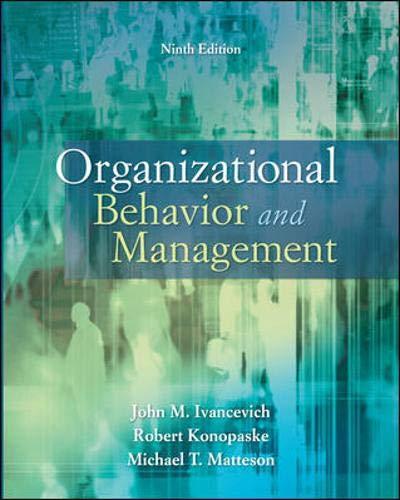Even in the midst of a severe recession that has depressed tourism and a digital revolution in
Question:
Even in the midst of a severe recession that has depressed tourism and a digital revolution in the media business, Disney is faring better than many of its rival companies. Although spending at its theme parks is down and fewer people are buying DVDs of recently released Disney movies (e.g., Bolt and Beverly Hills Chihuahua ), Disney has positioned itself well to ride out the recession by having a broad mix of businesses in its portfolio. For example, Disney’s sports cable network, ESPN, and ABC Family and Disney channels have reported an increase in operating profits in 2009.
The creation and marketing of well-known franchises such as the Jonas Brothers is helping to fuel the company’s success. The Jonases have already performed onstage to over a million people, sold over 750,000 copies of a book, starred in their own TV show on the Disney Channel, and will star in an upcoming full-length movie. Also, in an attempt to capture a larger share of the growing online viewer market, Disney recently bought an equity stake in Hulu, the online video platform. In addition, the Disney Pixar creative partnership (Disney bought Pixar) is continuing to produce popular and profitable animated movies such as Wall-E and Up .
To what degree have these business decisions been successful? Disney was ranked 67 th in the Fortune 500 list of largest companies in 2008. Also, it surpassed other media companies, including Time Warner and News Corp., in terms of its stock performance and return on invested capital. Disney has become the largest media conglomerate in the world with a market value of about \($40\) billion.
Who has been the driving force behind many of these business decisions? Robert (“Bob”) Iger took over as CEO in 2005. Known to many as “hardworking and likable,” Iger has not only had to make a series of important business decisions regarding Disney’s current businesses and future direction, but he has also had to repair several important relationships that the former CEO, Michael Eisner, strained during the later stage of his 22-year tenure.
Disney’s controversial ex-CEO, Eisner, was credited with helping to turn around Disney in the 1980s and once again making it into a formidable American company. In the mid-1990s, Eisner astutely guided the company to add Capital Cities/
ABC and ESPN to its theme park and film businesses.
Following these and other well-received decisions, Eisner’s abrasive style and tendency toward micromanagement led to a series of public disputes and feuds with key players in the Disney world. Eisner fought with Miramax founders Harvey and Bob Weinstein over the financial details related to Disney’s purchase of Miramax films. Eisner and Steve Jobs, then CEO of animated film producer Pixar, bumped heads several times. While testifying in front of Congress about movie piracy, Eisner made some negative comments about Apple Computer (of which Jobs is also CEO). Jobs took this jab personally and did not forgive Eisner for making these comments.
This feud eventually culminated with Jobs threatening to not renew the Disney–Pixar partnership after the release of Cars in 2006 if Eisner was still CEO of Disney. Eisner had a long-running dispute with two (former) influential members of Disney’s Board of Directors, Roy Disney and Stanley Gold, both of whom were outspoken critics of Eisner and his management team. For several years, these long-standing board members repeatedly called for Eisner’s resignation.
Soon after Iger took over as CEO at Disney in 2005, he reached out and reconciled the company’s differences with Roy Disney and Stanley Gold. They agreed to cease their “SaveDisney”
campaign and work cooperatively with Iger. The dispute with the Weinstein bothers was resolved by making a settlement payment of \($100\) million (Disney kept the Miramax name and film library estimated at a worth of \($2\) billion). Iger repaired the relationship with Steve Jobs and Pixar, ultimately paving the way for Disney to pay \($7.4\) billion in stock to acquire Pixar Animation Studios in 2006 and adding Steve Jobs to the Disney Board of Directors.
In sum, the change in leadership at Disney from Michael Eisner to Bob Iger seems to have been a prudent one. Iger and his management team have made a series of good business decisions while systematically repairing key relationships that were strained during Eisner’s reign as CEO.
Questions 1. How would you describe the conflict between Michael Eisner and the Weinstein brothers, the two board members (Disney and Gold), and Steve Jobs? Was it functional or dysfunctional?
2. Think back to the stages of conflict described in this chapter. Which stage best described the conflict between Eisner and Jobs? Was it perceived, felt, or manifest?
3. Which of the following best describes Michael Eisner’s and Bob Iger’s approaches to resolving conflict: dominating, problem solving, avoiding, or accommodating? Explain.
4. To what degree do you think Iger’s calmer and less confrontational approach to running Disney has helped the company position itself to survive a major economic recession?
Step by Step Answer:

Organizational Behavior And Management
ISBN: 9780073530505
9th Edition
Authors: John Ivancevich, Robert Konopaske, Michael T Matteson





